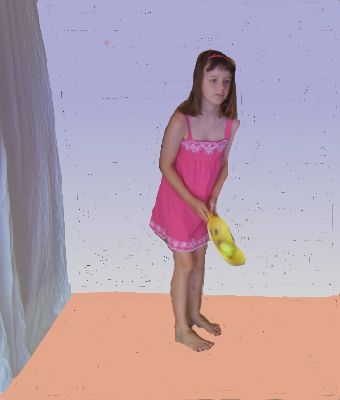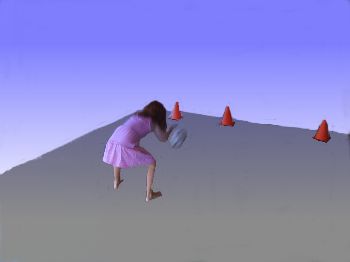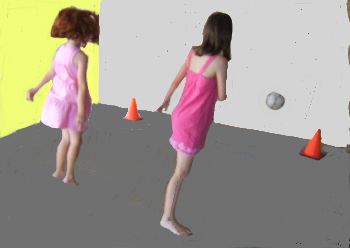Equipment - A net strung half-way across the squash court 8 feet from the floor.
Team composition - 4 players
Object of the game - to ground the ball in the opponent’s court or force the opponents into error. Each team is allowed 3 touches before returning the ball over the net. Players must not hit the ball twice in a row, e.g., shoulderthen hand.
To commence the game -the ball is rallied between the teams, with a minimum of 3 crosses of the net. The team which causes the ball to fault after 3 crossings of th net, passes right of lst service to the opposing team.
Service
1.The server stands with at least 1 foot in the back right hand corner within an imaginary 1 metre square and has ONE serve which must clear the net.
2. A clenched fist or open hand may be used. An under arm serve MUST be used.
3.If the ball touches the net tape on service and bounces, or would have bounced on the opponent’s court floor a let shall be played. That is replay the service.
4.A serve may not hit any walls on the full: a fault will be called and service given to the opposing team.
5. A server must hit the ball within 5 seconds after the Referee has called play.
6. A serve made before the Referee’s call may be cancelled and then must be replayed.
7.When one team reaches “seven” (7), teams change sides.
8.If the ball is thrown and missed on service, a fault will be called and service passes to the opposing team.
9.When the team receiving the serve wins the exchange of plays or the opponent commits a fault, it wins the right to serve and its players must rotate one position clockwise.
10.The rotation order as recorded on the score sheet at the beginning of each set must remain the SAME throughout the set, on BOTH sides of the court. After the ball has been received, players may play outside that position until the end of the rally.
11.The receiving team may not return the serve on the first contact from the front of the court, unless the ball has dropped well over the net, i.e., level with the bottom of the net, or unless the ball is returned as a lob.
12.The ball cannot be blocked, spiked or forcefully returned from the front half of the court off the serve.
The game -
1. A ball driven into the net may be recovered provided that it does not touch the floor nor is contacted a fourth time.
2. The ball must not be thrown or otherwise held but must be HIT cleanly.
3. A faullt will be called if the ball is contacted with any part of the body below the waist.
4. With the exception of the feet, it is forbidden for a player to contact any part of his/her body beyond the centre line within the opponent’s court, while in play. To touch the opponent’s court with a foot or feet is allowed providing that some part of the encroaching foot or feet remains in contact with or above the centre line.
5. A player must not touch the net or interfere with an opposing player. If the netis touched a fault will be called and that team will lose the rally.
6. Ceiling, lights and light protectors are OUT.
7. The back and side walls of the opposing team’s side of the net may be used (except on service) below the string line. The play may continue after the ball has hit such walls provided it has not hit the floor. On or above the string line is OUT.
8. Fouls - Feet on walls constitutes a FOUL even between or after a rally and loss of the rally. Kicking a ball constitutes a point to the opposition. Abusive language to other players, or refere constitutes a point to the opposing team as does court or equipment abuse.
9. Substitutes - Can be made at the end of a game, not during, unless an injury occurs to a player/s. Two substitutes at a time only. Substitution players are allowed for all teams.
BLOCKING -
1. A block does not count as a contact. After blocking, a team is entitled to 3 more contacts to send the ball to the opponent’s court.
2. The first contact after the block may be made by any player, even if a player had touched the ball during the block action.
3. A fault will be called if a player blocks a ball inside his/her opponent’s space, either before or during the action, i.e., no hands across over net.
SPIKING - Mixed/Ladies Leagues -Spiking is NOT allowed and should be penalised by the Referee. Men’s Leagues - When a ball is spiked towards the back or side wall, and that ball strikes a player of the opposition team intentionally, a fault is incurred by the team whose player spiked the ball. This rule is to discourage dangerous play, whereby players could be injured by spiked balls. A Referee in making a decision in such a case, should be satisfied that such spiked ball would have hit the rear or side wall on the full, if that ball had not struck the opposing player. A ball spiked must hit only one wall before hitting the floor. Also a ball spiked to the back wall must hit the floor before passing back under the net.
SCORING Ladies/Mixed Only the serving team can win a point. If the serving team hits out or fouls, the service changes to the other side. The game is scored to 15 points, winning by at least 2 points, e.g., 17-15. The team which LOSES the previous game will begin serving the next game. The losing side, can choose which side of the court to serve from. The winner of the match must win 3 games (5 games are played). Mens Teams play on a handicap system to 15 points each game. Every rally counts, irrespective of which team serves. TERMS
1. CARRY BALL - To carry a ball, there must be more than a momentary touching of the ball. This includes pushing, cupping, palming and lifting the ball. A team guilty of CARRY BALL loses the rally.
2. HAND OUT - When the serving team incurs a ball-handling fault, it loses the right to continue to serve, and must HAND OVER the ball to the opposing team.
3. SPIKE - A striking of the gball with force, with an over-hand motion. 4. Any ball which ascemds after it is struck IS NOT a spike. MIXED TEAMS - Must have at least one woman and no more than two men on the court at all times. PROGRESSIVE POINTS LADDER 1 point for each game won. FINALS Players must have played at least 5 matches during the season to qualify for finals.



